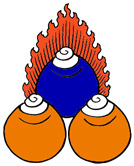| |

Studies
in
Buddhadharma
On Nectar : Life, Strength, Health !
 Contents
Contents  SiteMap
SiteMap

"Amitâyus, Protector and Bhagavân,
(...) bless me by pacifying conditions, leading to untimely death arising
from humans or non-humans, and from degeneration of lifespan and merit by
the power of previously accumulated sins. Please confer the siddhi
of immortality now, when I have brought together all that is good in
samsâra and nirvâna and when my mental stream and depleted life
force are about to blossom with merit and life."
Seventh Dalai Lama : Amitâyus Longevity Yoga.
|
In Hinduism, the water of life or nectar of immortality is called "amrita"
("immortal"). It is frequently employed in the Vedas (cf.
"soma"), but is also part of Śivaite Tantra, where it is coupled with
"rakta" ("blood") and its associated sacrificial practices.
In the Sâdhana of Amitâyus (the Buddha of Boundless Life, a manifestation
of Amitâbha, the Buddha of Boundless Light), the long-life vase containing
the nectar of immortality ("amrita") appears. It is employed in longevity
rituals, aimed to increase the lifespan of practitioners with the
intention to benefit sentient beings longer.
In the iconography of Padmasambhava, the long-life vase returns, but rests
in the skull-cup ("kapila"), representing the polarity symbols of white &
red "drops" essential in all Highest Yoga Tantras.
|
In Tantras of the Father (method) class, method is represented
by the white drops situated in the crown wheel, and wisdom by the red
drops in the navel wheel. The Lunar white drop (from the father) is linked
with "amrita" and the "method" of the long-life vase, whereas the Solar
red drop (from the mother) is "rakta" ("blood") and the "wisdom" of the
skull-cup (in Mother tantras, stressing wisdom, these polarities may be
reversed). The white drops sustain the solid white organs of bone, brain,
marrow & spinal cord, whereas the red drops gives rise to the soft red
organs of viscera, blood & muscle tissue. These equivalences are not
direct, but indirect by way of
hylic-pluralistic multicorporality, in particular the subtle anatomy
of the "Vajra body" with its "wheels" ("ćakra"), "channels" ("nadî") &
"winds" ("prâna" or "ch'i").
These two drops may also be depicted in two separate skull-cups, placed as
offerings in front and to the left & right of one's meditational deity
("yidam"). Between these two cups, a third one represents the offering of
the five sense organs. The white drop represents the "white" male semen
("kunda"), the red drop the fertile "red" uterine blood ("rakta"), and the
five sense organs symbolize the consciousness seeking rebirth. The
latter is not the mortal gross & subtle minds, but the immortal very
subtle mind of Clear Light.
Uniting white (long-life vase) and red (skull-cup) drop is the tantric
equivalent of merging method (cf. form-bodies or "Rûpakâya" =
"Sambhogakâya" + "Nirmânakâya") and wisdom (cf. "Dharmakâya"), the state
of an Awakened One. This fusion into "one taste" ("ekârasa") or "unio
mystica", is represented by the tantric manifestation of
Buddha Śâkyamuni,
i.e. Vajradhara, who holds the Vajra (method) in his right hand and the
Bell (wisdom) in his left.
The Vajrayâna knows
long life rituals to give teachers the opportunity to stay in their bodies
longer, continuing their spiritual practices benefitting sentient beings.
Increasing the drops, in particular the white immortality nectar,
lengthens one's lifespan. Although
Great
Perfection practices, like Calm Abiding on the Six Perfections,
resulting in a good heart & a calm mind, automatically increases the
number of drops, specific tantric "sâdhanas" (like those of Amitâyus or
the White Tara) introduce a "turbo-effect", allowing -so tradition has it-
a dramatically increase of one's lifespan (myth has it Nâgârjuna lived
for centuries, while Padmasambhava is deemed to still walk the Earth
today) ...
To understand these drops better, please consult my study on
Tantra.

|
|



